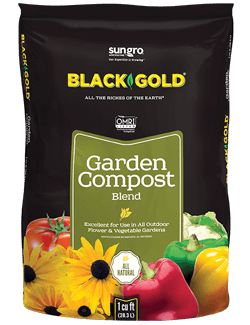
Here in the Pacific Northwest temperatures seem to be getting warmer and warmer in the spring. We have finally had some sunny days, and the temperature actually reached the 80’s. How nice it was to see the sun, and what a wonderful feeling to get outside in the garden without a jacket.
I always like to visit other gardens and made a recent visit to the garden of a friend to check on the status of his garden peas. Since peas like cool weather, they have done just fine. It is so nice to see his raised vegetable beds. He worked Black Gold Garden Compost Blend into the soil at time of planting, and the plants look great. The fine compost gives his beds a ‘finished’ look.
If you have held off on planting your summer vegetable garden, it should be all right to do so now. Beans are very easy to grow  from seed. Once the soil has warmed, they germinate quickly and are a good crop for children to grow. Cucumbers, squash, pumpkins, and corn can also be planted from seed. If you just need a few plants, save time by buying individual starts at your local garden center.
from seed. Once the soil has warmed, they germinate quickly and are a good crop for children to grow. Cucumbers, squash, pumpkins, and corn can also be planted from seed. If you just need a few plants, save time by buying individual starts at your local garden center.
With the arrival of warm weather, basil can finally be planted. Basil definitely needs heat and is one of the last plants I set out in spring. I wait until the nights and days are both warm. Try growing basil in containers on a deck or patio. As long as it has full sun, it should thrive. At our house, we always have basil in several pots on our deck. Black Gold Natural & Organic Potting Soil is a great mix for basil planting. (Basil deserves to be planted in an organic potting soil!)
There are many different types of basil to grow. In addition to the familiar large-leaf Italian sweet basil, consider growing ‘Dark Opa” for its flavorful dark-red leaves or ‘African Blue’ for its purple-tinted leaves. A new one for me this year is ‘Pesto Perpetuo’, which has variegated leaves that are light green with a cream margin. The contrasting color of the leaves make this basil stand out nicely against the reddish stems.

Gunnera tinctoria is a plant that always amazes me with its giant leaves and fast growth. Mine are already over 6 feet tall and growing. My Gunnera is also sending up a flower stalk which looks somewhat like a corn cob. Sometimes garden centers will label Gunnera as “The Dinosaur Food Plant” because it is an ancient plant and is found in fossils. Here in the metro Portland (Oregon) region, I have had good success with Gunnera even though it is not considered winter hardy here. Once we have had a frost, I cut the huge leaves and cover the crown of the plant with them for winter protection. I then cut the stems and insert them through the leaves and into the soil to help anchor them. This has provided enough protection for my plant that it has survived for the past five years even though we have had some very cold temperatures.
My experience is that Gunnera does best with some shade, especially protection from the hot afternoon summer sun. It also requires plenty of moisture and a soil rich in humus. I planted mine with about a 50% mixture of Black Gold Garden Compost Blend and good garden loam. I also use two applications of an all-purpose fertilizer later in the season.
Roses should be coming into bloom, and this is the time to fertilize them with a quality rose food. Roses expend so much energy with their continuous flowering, it is wise to fertilize on a regular basis (perhaps every four weeks) during the growing season. I always like to make one application of blood meal because of the high- and fast-acting nitrogen content. For an easy-care shrub rose, consider a Knock Out®rose. While not the traditional cutting rose, ‘Knock-Out’ bears flower clusters that bloom all summer, and it has never had a trace of disease.

The hardy banana, Musa basjoo is another good summer plant for Pacific Northwest gardens. When the word ‘hardy’ is used, it refers to the roots as being hardy, not the leaves. Like a perennial, this plant will die to the ground in the winter and return from the roots in spring. I have had it planted in my garden for over 10 years. When the first frost comes, I take the old leaves and cover the entire ground area with them.
I am amazed at how tall my hardy banana has already grown this year, considering our cool weather. Typically, I apply a quality all-purpose fertilizer as it begins to grow. By the end of August, it will reach 12 feet and tower above most other plants in my garden.

A final plant to mention is Romneya coulteri (Matilija Poppy). Each bloom has magnificent white crinkled petals with a cluster of yellow stamens in the center. The foliage is bluish, so the plant attracts attention in the garden, even when it is not in bloom. If you are looking for a plant that will grow well in sunny, hot, dry space, this is it. The only other requirement is that it needs good drainage. Once established, no summer watering is required.
So many plants to choose from! Check out your local garden center, and try something new. I always try to find some plants to add to the garden that are not familiar but look exciting.

